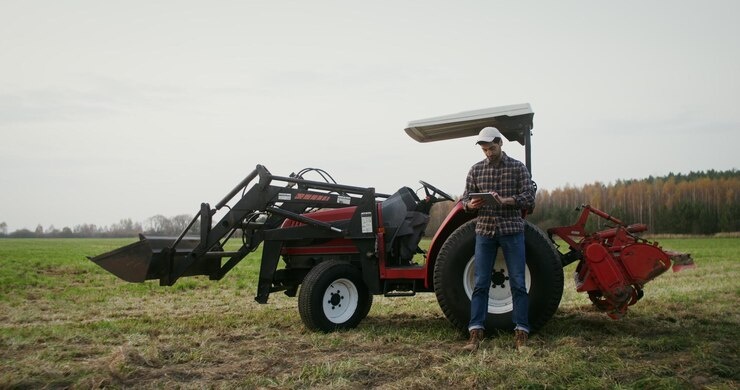Top 8 Agricultural Machines Explained: Every Farmer Should Understand and Use
This guide introduces the top eight agricultural machines that every farmer should be familiar with, along with their purpose and practical benefits.
Context: Why Agricultural Machinery Matters
Agricultural machinery refers to a wide range of equipment used in farming to perform various tasks such as tilling, planting, harvesting, and processing. These machines have revolutionized agriculture by making tasks faster, more precise, and less physically demanding.
Traditionally, farmers relied on animal power and hand tools, but with the growing need for higher output and reduced labor costs, mechanization has become a cornerstone of modern agriculture.
Importance: How Machines Solve Problems on the Farm
Using agricultural machines brings many benefits, including:
-
Efficiency: One machine can do the work of multiple laborers in a fraction of the time.
-
Precision: Machines ensure uniform seeding, fertilization, and irrigation.
-
Cost-effectiveness: Though the initial investment is high, machines reduce long-term labor and input costs.
-
Timeliness: Timely operations like sowing and harvesting are critical to crop success and income.
For small farmers, using the right tools can mean the difference between profit and loss. These machines help tackle labor shortages, boost productivity, and promote sustainable practices.
Recent Updates: Trends in Farm Machinery (2024–2025)
The agricultural machinery sector has seen rapid innovation:
| Trend | Impact |
|---|---|
| Compact and multi-purpose machines | Designed for small landholders and marginal farmers |
| Smart tractors with GPS and AI | Help optimize routes, reduce fuel usage, and improve precision farming |
| Battery-powered tools | Eco-friendly alternatives to diesel-powered machines |
| Government subsidies on machinery | In 2024–2025, many states in India and other countries offer 30–50% subsidies on farm equipment |
| Drone-based spraying and monitoring | Supplement traditional machinery, especially for large farms |
Top 8 Essential Agricultural Machines
Here’s a closer look at the most important machines every farmer should know:
1. Tractor
Use: Hauling, tilling, planting, spraying, and powering other implements.
Why it’s essential: The backbone of farm mechanization. Tractors come in various sizes and can be customized with attachments for almost any task.
Bonus Tip: Choose horsepower (HP) based on land size—25–45 HP is good for small farms; over 60 HP for large operations.
2. Rotavator (Rotary Tiller)
Use: Prepares the seedbed by breaking, mixing, and leveling soil.
Why it’s essential: Saves time and fuel compared to traditional plowing. Helps in weed control and improves soil structure./
Used best after initial plowing for fine tilth and better germination.
3. Seed Drill
Use: Sows seeds at the correct depth and spacing.
Why it’s essential: Ensures uniform crop growth and efficient use of seeds.
| Manual vs. Mechanized Seed Drills |
|---|
| Manual: For small plots and marginal farmers |
| Mechanized: Ideal for medium to large farms with tractor power |
4. Combine Harvester
Use: Reaps, threshes, and cleans grain crops in a single process.
Why it’s essential: Reduces harvest time dramatically and prevents crop loss. Commonly used for wheat, rice, barley, and soybeans.
In 2025, newer models come with yield monitors and real-time data output for farm analysis.
5. Power Tiller
Use: Multi-purpose tool for small-scale farmers—can plow, weed, sow, and spray.
Why it’s essential: Low-cost alternative to tractors; ideal for hilly terrain and fragmented landholdings.
Often subsidized under small farmer schemes.
6. Sprayer (Manual, Motorized, or Drone)
Use: Applies pesticides, herbicides, and fertilizers evenly across crops.
Why it’s essential: Protects crops from pests and ensures proper nutrient delivery.
| Type | Best Use |
|---|---|
| Manual | Small fields |
| Motorized | Medium farms |
| Drone | Large farms, orchards, uneven terrain |
7. Baler Machine
Use: Collects and compresses crop residue like hay or straw into bales.
Why it’s essential: Eases transport, storage, and use of crop waste for fodder or fuel.
Reduces air pollution from stubble burning by promoting straw reuse.
8. Cultivator
Use: Loosens and aerates the soil, removes weeds, and mixes compost/fertilizer.
Why it’s essential: Ensures better soil health and root penetration.
Available as tractor-mounted or manual models for different scale operations.
Laws or Policies Affecting Agricultural Machinery
In many countries, agricultural machinery is supported by national and regional schemes. In India, for example:
-
Sub-Mission on Agricultural Mechanization (SMAM): Offers 40–60% subsidies on selected farm machines.
-
PM-KISAN Scheme: Though primarily an income support scheme, it indirectly helps farmers invest in tools.
-
Custom Hiring Centers (CHCs): Government-supported centers allow farmers to rent expensive machines at low cost.
-
FAME-II: Promotes battery-operated machinery under the green energy initiative.
Globally, countries are promoting mechanization through import/export incentives, low-interest loans, and smart-farming initiatives.
Tools and Resources for Farmers
| Tool/App | Purpose | Access |
|---|---|---|
| mKisan Portal | Government schemes and advisory services | mkisan.gov.in |
| AgriApp | Market prices, weather, and equipment tips | Android/iOS |
| Kisan Suvidha | Real-time weather, expert advice, market data | Android |
| Mahindra Trringo | Rent tractors and farm machines online | trringo.com |
| Krishi Jagran | News, reviews, and agri-machinery trends | krishijagran.com |
FAQs: Common Questions About Farm Machinery
Q1: Which machine should a small farmer buy first?
A: A power tiller or rotavator is ideal for small farmers. It prepares the land effectively and is more affordable than a full-size tractor.
Q2: Are government subsidies available for farm machines?
A: Yes. Schemes like SMAM in India and similar programs globally offer 30–60% subsidies. Farmers should check eligibility with local agriculture departments.
Q3: What’s the difference between a power tiller and a tractor?
A: A power tiller is smaller, hand-operated, and suitable for small plots. A tractor is vehicle-based, offers more power, and can handle large implements and bigger areas.
Q4: How often should machines be serviced?
A: Basic servicing should be done every 100–200 hours of use, and full maintenance at least once per season to avoid breakdowns during critical times.
Q5: Is renting machines a good option?
A: Yes. Renting from Custom Hiring Centers (CHCs) or private apps is cost-effective, especially for seasonal or expensive machines like combine harvesters.
Conclusion: Embracing Technology for Smarter Farming
Agricultural machines are transforming farms into productive, efficient systems. Whether it’s a simple sprayer or a GPS-enabled tractor, using the right tool can save time, reduce labor, and improve yields. Farmers—regardless of land size—should be aware of these machines, understand their functions, and explore options through government schemes or rental services.
Mechanization is not just for large farms. With the right knowledge and support, small and medium farmers can reap its benefits and build a more sustainable future.
